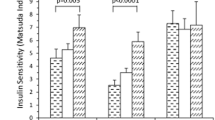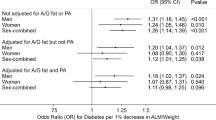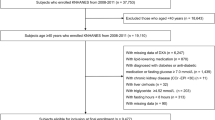Abstract
Background/Objectives:
There is a high prevalence of diabetes mellitus associated with insulin resistance in Indian adults, probably due to an inappropriately high accumulation of body fat at lower body mass indices (BMIs, kg/m2), as well as to a lower skeletal muscle mass. Although skeletal muscle is an important site of glucose disposal, the strength of its association with insulin sensitivity (IS) is unknown in the Indian population.
Subjects/Methods:
This was a cross-sectional study performed to assess the association of body fat, muscle and muscle function with IS in 51 young, healthy, nonobese Indian men with BMI ranging from 15 to 25 kg/m2, using hyperinsulinemic euglycemic clamp method.
Results:
The median IS was 5.32 (mg/(kg min))/(μU/ml), lower, upper quartile, 4.03, 6.56); (SI units: 4.25, lower, upper quartile, 3.22, 5.24 (μmol/(kg min))/(pmol/l)). A multiple linear regression of the natural log transformed value of IS on BMI and body muscle mass measured as the appendicular lean soft tissue (expressed as a percentage of body weight) explained 49% of the variance in IS. Independently, body fat percent and muscle (handgrip) strength showed significant bivariate correlations with IS (ρ=−0.61, P<0.001; ρ=0.32, P=0.027, respectively), although these variables did not enter into the multiple regression.
Conclusions:
BMI and body fat have been shown to be inversely related to IS at higher BMIs. This study indicates that a relative increase in BMI and reduced muscle mass and possibly function are also associated with reduced IS in lean Indian men.
This is a preview of subscription content, access via your institution
Access options
Subscribe to this journal
Receive 12 print issues and online access
$259.00 per year
only $21.58 per issue
Buy this article
- Purchase on Springer Link
- Instant access to full article PDF
Prices may be subject to local taxes which are calculated during checkout


Similar content being viewed by others
References
Abate N, Chandalia M, Snell PG, Grundy SM (2004). Adipose tissue metabolites and insulin resistance in nondiabetic Asian Indian men. J Clin Endocrinol Metab 89, 2750–2755.
Banerji MA, Faridi N, Atluri R, Chaiken RL, Lebovitz HE (1999). Body composition, visceral fat, leptin, and insulin resistance in Asian Indian men. J Clin Endocrinol Metab 84, 137–144.
Bhat DS, Yajnik CS, Sayyad MG, Raut KN, Lubree HG, Rege SS et al. (2005). Body fat measurement in Indian men: comparison of three methods based on a two-compartment model. Int J Obes (Lond) 29, 842–848.
Chandalia M, Abate N, Garg A, Stray-Gundersen J, Grundy SM (1999). Relationship between generalized and upper body obesity to insulin resistance in Asian Indian men. J Clin Endocrinol Metab 84, 2329–2335.
Chowdhury B, Lantz H, Sjostrom L (1996). Computed tomography-determined body composition in relation to cardiovascular risk factors in Indian and matched Swedish males. Metabolism 45, 634–644.
DeFronzo RA, Tobin JD, Andres R (1979). Glucose clamp technique: a method for quantifying insulin secretion and resistance. Am J Physiol 237, E214–E223.
Dela F, Larsen JJ, Mikines KJ, Galbo H (1995). Normal effect of insulin to stimulate leg blood flow in NIDDM. Diabetes 44, 221–226.
Deurenberg-Yap M, Chew SK, Deurenberg P (2002). Elevated body fat percentage and cardiovascular risks at low body mass index levels among Singaporean Chinese, Malays and Indians. Obes Rev 3, 209–215.
Dudeja V, Misra A, Pandey RM, Devina G, Kumar G, Vikram NK (2001). BMI does not accurately predict overweight in Asian Indians in northern India. Br J Nutr 86, 105–112.
Ebeling P, Bourey R, Koranyi L, Tuominen JA, Groop LC, Henriksson J et al. (1993). Mechanism of enhanced insulin sensitivity in athletes. Increased blood flow, muscle glucose transport protein (GLUT-4) concentration, and glycogen synthase activity. J Clin Invest 92, 1623–1631.
Elia M, Livesey G (1988). Theory and validity of indirect calorimetry during net lipid synthesis. Am J Clin Nutr 47, 591–607.
Galgani JE, Heilbronn LK, Azuma K, Kelley DE, Albu JB, Pi-Sunyer X et al. (2008a). Metabolic flexibility in response to glucose is not impaired in people with type 2 diabetes after controlling for glucose disposal rate. Diabetes 57, 841–845.
Galgani JE, Moro C, Ravussin E (2008b). Metabolic flexibility and insulin resistance. Am J Physiol Endocrinol Metab 295, E1009–E1017.
Hedman A, Byberg L, Reneland R, Lithell HO (2002). Muscle morphology, self-reported physical activity and insulin resistance syndrome. Acta Physiol Scand 175, 325–332.
Henriksen EJ (2002). Effects of acute exercise and exercise training on insulin resistance. J Appl Physiol 93, 788–796.
Henriksen JE, Levin K, Thye-Rønn P, Alford F, Hother-Nielsen O, Holst JJ et al. (2000). Glucose-mediated glucose disposal in insulin-resistant normoglycemic relatives of type 2 diabetic patients. Diabetes 49, 1209–1218.
Holloszy JO (2005). Exercise-induced increase in muscle insulin sensitivity. J Appl Physiol 99, 338–343.
Houmard JA, Egan PC, Neufer PD, Friedman JE, Wheeler WS, Israel RG et al. (1991). Elevated skeletal muscle glucose transporter levels in exercise-trained middle-aged men. Am J Physiol 261, E437–E443.
Kelley D, Mokam M, Venenam T (1994). Impaired post prandial glucose utilization in non-insulin-dependent diabetes mellitus. Metabolism 43, 1549–1557.
Kelley D, Mandarino LJ (2000). Fuel selection in human skeletal muscle in insulin resistance: a reexamination. Diabetes 49, 677–683.
Kim J, Wang Z, Heymsfield SB, Baumgartner RN, Gallagher D (2002). Total-body skeletal muscle mass: estimation by a new dual-energy X-ray absorptiometry method. Am J Clin Nutr 76, 378–383.
Koopman R, Manders RJ, Jonkers RA, Hul GB, Kuipers H, van Loon LJ (2006). Intramyocellular lipid and glycogen content are reduced following resistance exercise in untrained healthy males. Eur J Appl Physiol 96, 525–534.
Kurpad AV, Khan K, Calder AG, Elia M (1994). Muscle and whole body metabolism after norepinephrine. Am J Physiol 266, E877–E884.
Kurpad AV, El-Khoury AE, Beaumier L, Srivatsa A, Kuriyan R, Raj T et al. (1998). An initial assessment, using 24-h [13C]leucine kinetics, of the lysine requirement of healthy adult Indian subjects. Am J Clin Nutr 67, 58–66.
Kurpad AV, Regan MM, Raj T, Vasudevan J, Kuriyan R, Gnanou J et al. (2003). Lysine requirements of chronically undernourished adult Indian men, measured by a 24-h indicator amino acid oxidation and balance technique. Am J Clin Nutr 77, 101–108.
Misra A, Vikram NK (2002). Insulin resistance syndrome (metabolic syndrome) and Asian Indians. Curr Sci 83, 1483–1496.
Mohan V, Sandeep S, Deepa R, Shah B, Varghese C (2007). Epidemiology of type 2 diabetes: Indian scenario. Indian J Med Res 125, 217–230.
Morio B, Hocquette J-F, Montaurier C, Boirie Y, Bouteloup-Demange C, McCormack C et al. (2001). Muscle fatty acid oxidative capacity is a determinant of whole body fat oxidation in elderly people. Am J Physiol 280, E143–E149.
Nair KS, Bigelow ML, Asmann YW, Chow LS, Coenen-Schimke JM, Klaus KA et al. (2008). Asian Indians have enhanced skeletal muscle mitochondrial capacity to produce ATP in association with severe insulin-resistance. Diabetes 57, 1166–1175.
National Family Health Survey (NFHS-3) (2005–2006). National Fact Sheet (Provisional data) [Online]. Ministry of Health and Family Welfare, Government of India. http://www.nfhsindia.org/pdf/IN.pdf,accessed on 28 May 2007.
Oberbach A, Bossenz Y, Lehmann S, Niebauer J, Adams V, Paschke R et al. (2006). Altered fiber distribution and fiber-specific glycolytic and oxidative enzyme activity in skeletal muscle of patients with type 2 diabetes. Diabetes Care 29, 895–900.
Perseghin G, Price TB, Petersen KF, Roden M, Cline GW, Gerow K et al. (1996). Increased glucose transport-phosphorylation and muscle glycogen synthesis after exercise training in insulin-resistant subjects. N Engl J Med 335, 357–362.
Poehlman ET, Dvorak RV, DeNino WF, Brochu M, Ades PA (2000). Effects of resistance training and endurance training on insulin sensitivity in nonobese, young women: a controlled randomized trial. J Clin Endocrinol Metab 85, 2463–2468.
Raji A, Seely EW, Arky RA, Simonson DC (2001). Body fat distribution and insulin resistance in healthy Asian Indians and Caucasians. J Clin Endocrinol Metab 86, 5366–5371.
Shetty PS, Sheela ML, Murgatroyd PR, Kurpad AV (1987). An open-circuit indirect whole body calorimeter for the continuous measurement of energy expenditure of man in the tropics. Indian J Med Res 85, 453–460.
Taylor AW, Bachman L (1999). The effects of endurance training on muscle fibre types and enzyme activities. Can J Appl Physiol 24, 41–53.
Vaz M, Thangam S, Prabhu A, Shetty PS (1996). Maximal voluntary contraction as a functional indicator of adult chronic undernutrition. Br J Nutr 76, 9–15.
Acknowledgements
We acknowledge the Ajinomoto Amino Acid Research Program for funding this study. We also acknowledge the assistance of Dr S Sambashivaiah, Dr S Shastry, Dr Karthik and Mr Vincent in the conduct of these studies.
Author information
Authors and Affiliations
Corresponding author
Rights and permissions
About this article
Cite this article
Unni, U., Ramakrishnan, G., Raj, T. et al. Muscle mass and functional correlates of insulin sensitivity in lean young Indian men. Eur J Clin Nutr 63, 1206–1212 (2009). https://doi.org/10.1038/ejcn.2009.32
Received:
Revised:
Accepted:
Published:
Issue Date:
DOI: https://doi.org/10.1038/ejcn.2009.32
Keywords
This article is cited by
-
Metabolic rate of major organs and tissues in young adult South Asian women
European Journal of Clinical Nutrition (2019)
-
Ancient origins of low lean mass among South Asians and implications for modern type 2 diabetes susceptibility
Scientific Reports (2019)
-
Body mass index predicts insulin sensitivity during cardiac surgery: a prospective observational study
Canadian Journal of Anesthesia/Journal canadien d'anesthésie (2018)
-
Height, adiposity and hormonal cardiovascular risk markers in childhood: how to partition the associations?
International Journal of Obesity (2014)
-
Muscular strength and markers of insulin resistance in European adolescents: the HELENA Study
European Journal of Applied Physiology (2012)



